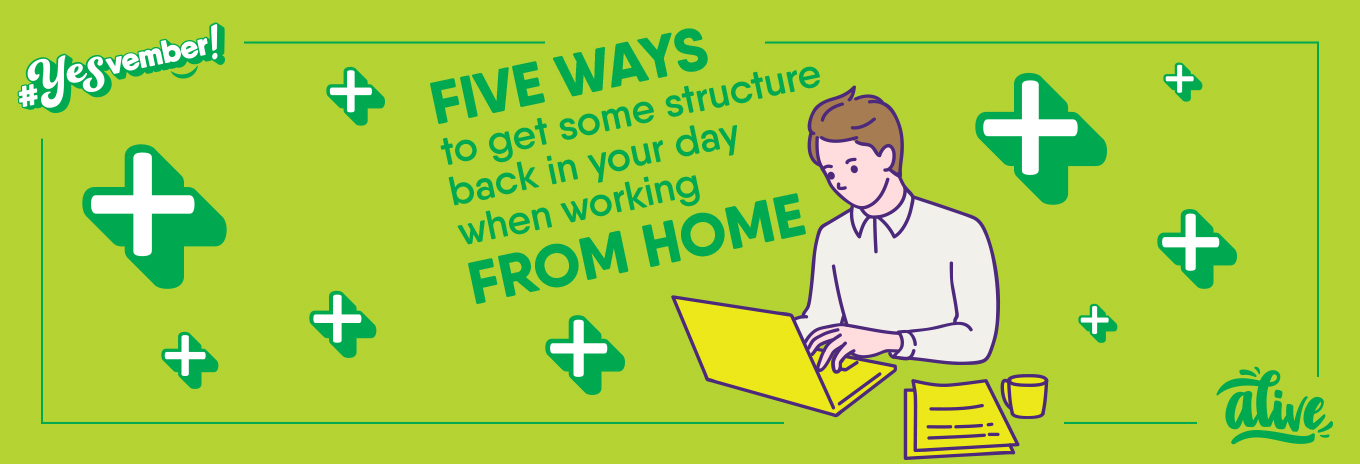As much as we all enjoy a change sometimes, we are creatures of habit. Routines are a way we feel secure, whether it’s having a whole meal plan set out for the week, or just knowing what the first thing you’ll do when you get home is.
If, like me, you were travelling into the office every day and now working from home, you’ve probably also had your routine thrown completely out of the window. I’m a big believer in finding the silver linings, like saving money on my train fare! But also in acknowledging the truth: nobody’s finding this easy.
I’ve found getting a bit of structure back helps, so here are 5 tips I’ve used in case they’re helpful for you too.
I work in a talking therapy service – one of the IAPT services that are available on the NHS in every part of England – so I’ve picked up some great tips from the practitioners here. But I’m also sharing a few that I have just personally found work for me.
-
Worry time

This is one from my therapist colleagues. It’s a technique from Cognitive Behavioural Therapy for dealing with those unsolvable problems that play on your mind.
It’s hard to leave home problems at home and work problems at work when they’re the same place. They interrupt whether you’re trying to concentrate or relax.
Personally, ‘worry time’ has been like hiring a PA for my brain. It helped me stop problems barging in on my thoughts while I’m trying to do something else.
In a nutshell, you schedule time each day to think things through. Whenever a problem comes up that you can’t solve straight away, you put it on the agenda for that ‘worry time’ meeting with yourself.
Then, you’re not brushing it away or ignoring the problem when it comes to mind. You’re arranging to give it the focussed attention it deserves. Of course, it’s not quite as simple as that, and it does take practice but it’s useful.
The talking therapy service I work for has made this worry time video to explain it. And there are also a couple of Apps you can use:
- Reach Out Worry Time helps you list those unsolvable problems and during your scheduled ‘worry time’ you can work through them.
- The Worry Tree starts a step before, and helps you see whether the problem is solveable or not. It then ‘branches’ off so you can take action, or add it to worry time to think through later.
-
Know when you need a break

“Take your breaks” is advice I see all the time in the workplace wellbeing space. I completely agree it’s one of the best tips, but it’s easier said than done on those days when your workload is piling up faster than you can trawl through it.
So my tip isn’t about encouraging you to get away from your desk. It’s about recognising when you need to, so you can justify it when the deadlines seem more important.
Do you have those moments where you notice you’re really flagging? Where you end up losing more time than you saved by powering through, because now you’re making mistakes?
My tip is to work back from that and look for the early warning signs that you missed. Because when you can spot them, you can time your breaks like pit stops.
- Mindfulness is a really useful skill for this. It brings your attention to what’s happening now, and trains you to notice what you’re experiencing.
- If you’re in Hampshire, you can join us for a little intro to mindfulness in our Breathing Space class. Or reach for – Headspace.
-
Start the day with movement
We all know exercise is good for our mind and body – but have you wondered if any of the ways you’ve been feeling lately might be down to your lack of commute?
I am one of the fortunate ones that find a lot of positives in working from home. But after a few months, I definitely found it hard to get going in the morning.
Now, I can’t say I had that much exercise to lose from my routine. But it turns out that brisk walk from my car to the office was doing a lot for my mood without me realising it. There’s something in the fact that the less we do, the less we want to do. So even losing that little bit of movement from my day started a bit of a slump for me.
- If you’ve noticed similar, I found a CBT technique called Behavioural Activation really helpful for this. And if you’ve ever thrown yourself into a new activity, only to lose interest after a little while, it includes tips for staying motivated when starting something new.
-
Limit your media consumption

This tip is a little controversial as a marketing professional and writing for the blog of a comms agency… but have you noticed the more time you spend on the news and social, the worse you feel?
It’s hard because social can also be a lifeline. Especially now that we’re not able to catch up in person as often, I’m not suggesting we give up one of the only ways we can stay connected.
Like anything, the key is moderation and my tip is to use this as a way to add structure to your day too.
Set yourself a window each day to catch up on the news and social media, and be firm with yourself when you catch yourself reaching for the app outside of it.
I’ve found it helpful to pick a time when I’ll be interrupted, because it’s too easy to get drawn in. Mine is while I’m cooking dinner – a little scroll while I’m waiting for something to boil or bake or brown. Because I can’t be the only one, where the harder a day I’ve had, the less time I can be bothered to spend cooking? It works out well that when I’m feeling my least resilient, I’ve probably only got a few minutes waiting for the microwave to ping!
-
Schedule time to check in with family, friends and colleagues
We’re different things to different people, aren’t we? So it can feel awkward to be work-you and home-you in the same place. If you’ve found yourself applying the situational leadership model of management to the children, or attachment-parenting your colleagues, you wouldn’t be alone!
I know among my friends, we’re all noticing different challenges of being physically present at home, but not really able to be around. Or of finding extra time to stay in touch with people you’d usually bump into during the day.
One friend has started having virtual lunches with colleagues they’d usually chat with in the office, rather than trying to borrow from family time in the evening to stay in touch.
Another has set an hour after work to catch up with his partner like they used to when they got home, rather than popping in to see each other during the workday.
This tip isn’t easy, but if you can relate to this, I hope you can find something that works for you.
And if you feel like you’d benefit from some focussed support around your wellbeing, NHS talking therapy services across the country are still accepting referrals. If you’re over 16, registered with a GP in Hampshire, and not being supported by another mental health service, you can contact italk without needing to see your GP.
Outside of Hampshire, you can find your local talking therapy service on the NHS website.
By Sara Langston, Patient Engagement and Marketing Manager at italk.
















